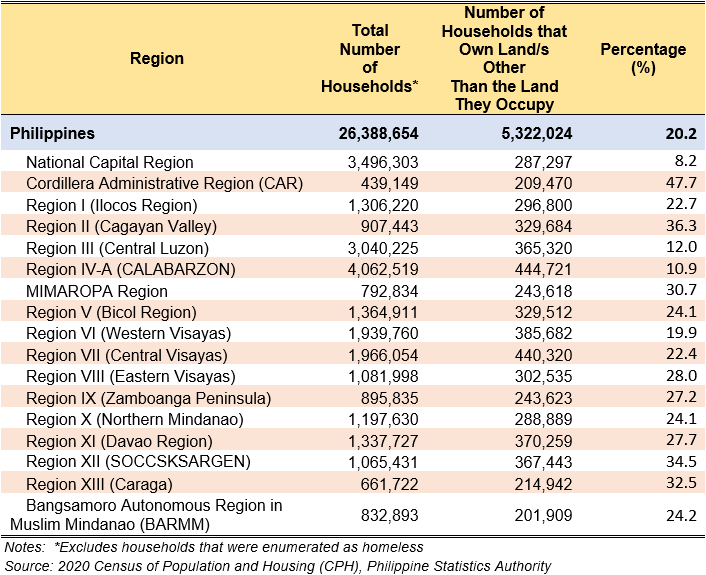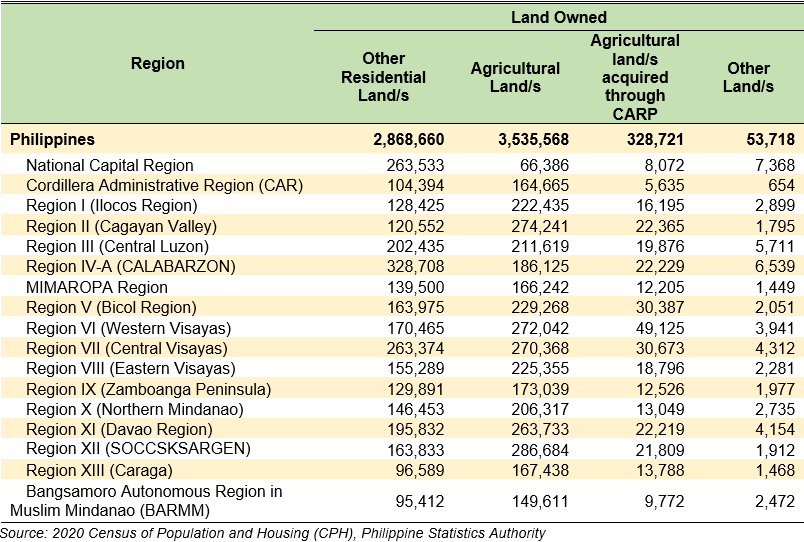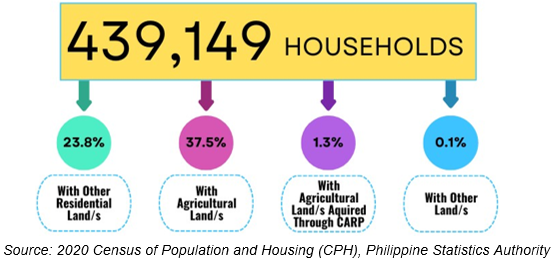The 2020 Census of Population and Housing (2020 CPH) took a snapshot of the Philippine population as of May 1, 2020. Pursuant to Proclamation No. 1179, s. 2021 signed on July 6, President Duterte has declared official for all purposes the population counts by province, city/municipality, and barangay. |
In the Philippines, 5,322,024 households or 20.2% of the total 26,388,654 households reported that they own at least one land apart from the land they occupy in 2020.
Table 1. Number of Households Reporting Land Ownership by Region,
Philippines: 2020

Cordillera Administrative Region (CAR) had the highest proportion of households with at least one type of land they owned other than they occupy, with 47.7% or 209,470 households. It was followed by Region II – Cagayan Valley with 36.3% (329,684 households), and Region XII – SOCCSKSARGEN with 34.5% (367,443 households).
On the other hand, the National Capital Region (NCR), had the lowest proportion of households with at least one type of land they owned other than the land they occupied with 287,297 households (8.2%).
Out of 26.4 million households, 3.54 million (13.4%) were reported to own agricultural land/s. Households that owned other residential land/s totaled 2.87 million (10.9%) while households that owned agricultural land/s acquired through the Comprehensive Agrarian Reform Program (CARP) as agrarian reform beneficiary reached 328,721 households (1.3%). Only 53,718 households (0.2%) had members that owned other types of land/s.
Table 2. Number of Households Reporting Land Ownership by Type of Land and Region,
Philippines: 2020

Figure 1. Percentage of Households with Land/s Other than the Land they Occupy
by Province, CAR: 2020

In the Cordillera region, 47.7% or 209,470 households of the total 439,149 households reported that they owned at least one land apart from the land that they occupied in 2020.
Among the provinces and Highly Urbanized City (HUC) in the Cordillera region, Mountain Province had the highest proportion of households with at least one type of land they owned other than the land they occupied with 73.3% (27,560 households). It was followed by Kalinga with 59.2% (28,483 households), and Ifugao with 58.3% (28,440 households).
On the contrary, the City of Baguio had the lowest proportion of households with at least one type of land they owned other than the land they occupied with 27.2% or 27,274 households.
Figure 2. Percentage of Households Reporting Land
Ownership by Type of Land, CAR: 2020

Of the total 439 thousand households, 37.5% (164,665 households) reported that they owned agricultural land/s. The number of households that owned other residential land/s recorded 104,394 (23.8%) while households that owned agricultural land/s acquired from the CARP reached 5,635 (1.3%). Only 654 households (0.1%) had members that owned other types of land/s.
Table 3. Number of Households Reporting Land Ownership by Type of Land and
Province, CAR: 2020

Benguet has most residential lands owners
In the Cordillera region, Benguet posted the highest number of households that own other residential lands other than the land they occupy in 2020, with 25.8% or 26,909 households. It was followed by the City of Baguio with 22.8% (23,854 households) and Kalinga with 11.9% (12,391 households).
Apayao reported the least number of households that owned residential lands with 7,245 households (6.9%).
Benguet records most agricultural lands owners
Benguet had the highest number of households that owned agricultural lands with 40,834 households or 24.8% of the total number of households that owned agricultural land/s in the Cordillera region in 2020. This was followed by Mountain Province with 25,292 households (15.4%), and Ifugao with 25,102 households (15.2%).
Ownership of agricultural lands was least in the City of Baguio with 11,020 households (6.7%).
Abra highest in agricultural land/s acquired through CARP
In the Philippines, CAR posted the least number of households that owned agricultural land/s acquired through CARP with 5,635 households (1.3%) in 2020.
Among the provinces and HUC in the region, Abra registered the highest number of households that own agricultural lands acquired through CARP with 1,447 households or 25.7%. It was followed by Kalinga with 1,153 households (20.5%), and Apayao with 942 households (16.7%).
Mountain Province registered the least number of households that owned agricultural land/s acquired through CARP in the region with 129 households (2.3%) only.
Only 654 households in CAR are owned other types of land
The number of households that owned other types of land recorded the highest in Benguet in 2020 with 216 households or 33.0% of the total number of households that owned other types of land in CAR. Other lands include lands that are used for commercial, industrial, or recreational purposes. This was followed by the City of Baguio with 151 households (23.1%) and Kalinga with 121 households (18.5%).
CAR posted the smallest number of households that owned other types of land with 654 households (1.2%) in the country at the time of census in 2020.
(SGD)
ALDRIN FEDERICO R. BAHIT, JR.
(Chief Statistical Specialist)
Officer-In-Charge
Special Order No: 2024ORDCAR-160
/RJPA/OPC
Technical Notes
I. Method of Enumeration
The population and housing censuses in the Philippines are conducted on a “de jure” basis, wherein a person is counted in the usual place of residence or the place where the person usually resides. The enumeration of the population and collection of pertinent data in the 2020 CPH referred to all living persons as of 01 May 2020.
For land ownership in the 2020 CPH, the respondent was asked, “Does any member of this household own the following…?” This determines if the household has any member/s who own other lands aside from the one that household is currently occupying. The data were collected using the CPH Form 2 (Common Household Questionnaire).
II. Data Limitations
The reported number of households in the Cordillera region in this report is not the actual total number of households in the region since the data on land ownership excludes households enumerated as homeless. The total number of households in CAR in 2020 is 439,166 while the coverage of this special release includes only 439,149 households.
The statistics presented in this report were based on the information provided by the respondent or any responsible household member who may provide accurate answers to the questions and give correct information about all the household members.
III. Definition of Terms
Household
A social unit consists of a person or a group of persons who sleep in the same housing unit and have a common arrangement in preparing and consuming food.
Agricultural Land/s
Land/s devoted to or suitable for the cultivation of the soil, planting of crops, growing of trees, raising of livestock, poultry, fish or aquaculture production, including the harvesting of such farm products, and other farm activities and practices performed in conjunction with such farming operations by persons whether natural or juridical and not classified by law as mineral land, forest land, residential land, commercial land, and industrial land.
Residential Land/s
All lands that have been identified and zoned as residential through the appropriate ordinance by the Local Government Unit (LGU) having jurisdiction over the area. These include residential lands within areas zoned as mixed residential and commercial or mixed residential and industrial (Source: RA 10023, Series of 2010).
Other Residential Land
Refers to residential lands that the household owns other than the one they are occupying.
Other Land/s
Includes commercial lands, industrial lands, ancestral domains, and ancestral lands. The last two categories are distinguished from Torrens Title and other tenurial instruments granted by a government agency or by the court.
Agricultural land/s, acquired through Comprehensive Agrarian Reform Program, Agrarian Reform Beneficiary
Pertains to land ownership acquired through Emancipation Patent (EP) Holder, Certificate of Land Ownership Award (CLOA), and Homestead Patent (HP), Leasehold Contract (LC).

